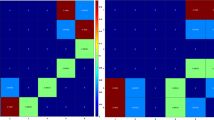Abstract
An interchange optimization algorithm to construct partially-latinized designs is described. The objective function is a weighted linear combination of up to five functions, each of which corresponds to a blocking factor of the required design. Nested simulated annealing is used to address local optima problems. The average efficiency factors of the generated designs are assessed against theoretical upper bounds.
Similar content being viewed by others
Explore related subjects
Discover the latest articles, news and stories from top researchers in related subjects.References
Eccleston, J. A. and Hedayat, A. (1974) On the theory of con-nected designs: characterization and optimality. Ann. Statist., 2, 1238–55.
Eccleston, J. A. and McGilchrist, C. A. (1985) Algebra of a row-column design. J. Statist. Planning and Inference, 12, 305–10.
Harshbarger, B. and Davis, L. L. (1952) Latinized rectangular lattices. Biometrics, 8, 73–84.
John, J. A. and Street, D. J. (1992) Bounds for the effciency factor of row-column designs. Biometrika, 79, 658–61.
John, J. A. and Williams, E. R. (1982) Conjectures for optimal block designs. J. Roy. Statist. Soc. B, 44, 221–25.
John, J. A. and Williams, E. R. (1995) Cyclic and Computer Generated Designs. Chapman & Hall, London.
Payne, R. W., Lane, P. W., Digby, P. G. N., Harding, S. A., Morgan, G. W., Todd, A. D., Thompson, R., Tunnicliffe Wilson, G., Welham, S. J. and White, R. P. (1993) Genstat 5 Release 3 Reference Manual. Oxford: Clarendon.
SAS Institute (1992) SAS/STAT Software, Release 6.07. Cary: SAS Institute.
Shah, K. R. (1960) Optimality criteria for incomplete block de-signs. Ann. Math. Statist., 31, 791–94.
Whitaker, D. (1995) Nested simulated annealing algorithm. J. Statist. Comp. Simul., 53, 233–41.
Whitaker, D., Williams E. R. and John, J. A. (1997) CycDesigN: A Package for the Computer Generation of Experimental Designs. CSIRO, Canberra.
Williams, E. R. (1986) Row and column designs with contiguous replicates. Austral. J. Statist., 28, 154–63.
Williams, E. R. and John, J. A. (1993) Upper bounds for latinized designs. Austral. J. Statist., 35, 229–36.
Rights and permissions
About this article
Cite this article
John, J.A., Williams, E.R. Partially-latinized designs. Statistics and Computing 9, 203–207 (1999). https://doi.org/10.1023/A:1008969914035
Issue Date:
DOI: https://doi.org/10.1023/A:1008969914035



